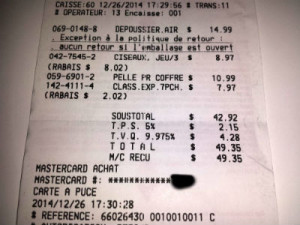One of the strangest things I found when arriving in Canada was “tax”. In my home country we don’t pay taxes in the same way we do here. In Canada basically there are two types of taxes that you and me, regular guys living our lives, have to worry about. One of them is what I call retail taxes. The other is Income Taxes. Maybe we’ll talk about Income Taxes someday in the future, but for now let’s just focus on retail taxes.
Here in Canada, when you go shopping, the price you see on the tags and shelves are the price before taxes. It’s super important that you get used to it as soon as possible to avoid any budget pitfall. The price on the tag is not the price you will effectively pay!
For example: you go to the supermarket and see a cereal box with a $4.50 price. Over the cashier, it will cost you more, depending on what province you live on — Were you really thinking it was that easy? Hold on to your seat:
Letter Soup
Some provinces have GST and PST, others have only HST, and Quèbec has GST and QST. Tip: Quèbec is always –let’s say– “different”.
GST stands for Goods and Services Taxes, and are imposed by the federal government.
PST means Provincial Services Taxes, and are imposed by the provincial government.
HST stands for Harmonized Sales Taxes.
A receipt showing the GST and PST taxes
Basically, when you buy something, you have to pay the federal government part (GST) and the provincial government part (PST, or QST if you are in Quèbec). What happens is that some provinces use what is called HST, what means their provincial and federal taxes are combined, or “harmonized”. It does not necessary mean that you are paying less taxes, it’s only a way to “simplify” things.
A receipt showing the GST/HST taxes
The provinces that participate in the HST program are New Brunswick, Nova Scotia, Newfoundland and Labrador, Ontario and Prince Edward Island. All other provinces apply the GST+PST schema (except Quèbec. Well, the QST is a Provincial tax, but Quebecers like to complicate things and they call their provincial taxes QST just to be different. In practical terms, it’s the same thing).

And a receipt showing the GST/QST taxes. It’s french, mon amour.
GST/PST/HST Rates
Here you can see the various rates for GST, HST, PST (or QST) for and each province in Canada (font):
| Province | Type | PST (%) |
GST (%) |
HST (%) |
Total Tax Rate (%) |
Notes: |
| Alberta | GST | 5 | 5 | |||
| British Columbia | GST + PST | 7 | 5 | 12 | As of April 1, 2013, the HST rate no longer applies in British Columbia. | |
| Manitoba | GST + PST | 8 | 5 | 13 | ||
| New Brunswick | HST | 13 | 13 | |||
| Newfoundland and Labrador | HST | 13 | 13 | |||
| Northwest Territories | GST | 5 | 5 | |||
| Nova Scotia | HST | 15 | 15 | WARNING: Highest total rate! | ||
| Nunavut | GST | 5 | 5 | |||
| Ontario | HST | 13 | 13 | |||
| Prince Edward Island | HST | 14 | 14 | |||
| Quebec | GST + *QST | *9.975 | 5 | 14.975 | ||
| Saskatchewan | GST + PST | 5 | 5 | 10 | ||
| Yukon | GST | 5 | 5 |
The good news is that you can see exactly how much taxes you are paying and, in some provinces, who is receiving your hard earned money: on your receipt you will see the federal tax value and the provincial tax value, both clearly stated. What is it good for? That’s a good question. One could argue that it helps in educating people about the tax system. In some countries you just don’t have the slightest idea about how much money you are paying in taxes because they are hidden deeply in the item’s price.
The bad news is: there is no way to save on retail taxes, except moving to another province. Sorry to disappoint you, guys. Some stores will say sometimes “the taxes are on us” on special occasions like Black Friday, but it’s not actually true. You will get a discount that will equal the tax rate for the province, and the taxes will be there on top of the discounted value. In this case it pays off to live in Nova Scotia or Quèbec: 15% off is often a good deal.
This is pretty much all you need to know about retail taxes in Canada. We could dive into a lot of more specific and detailed (complicated) questions related to tax laws, how are the taxes divided between the provinces and the federal government, how are these taxes applied in services for the population, and so on… But let’s just call it a day and leave all of this for another opportunity, shall we?
Anything else you’d like to know about retail taxes in Canada? Let me know in the comments.
Do you think any friend can benefit from the information on this post? Share it with your social networks using the buttons below.
Photo by Flickr user Image Editor.

Great article Dan! I’ve been meaning to write a similar article myself that goes into detail about how receipts work and what the various codes mean.
Wow, that would be something amazing to see! Don’t give up on this idea. Unknown numbers and codes always bother me! :D
Thanks for stopping by and commenting! Nice to see you around!